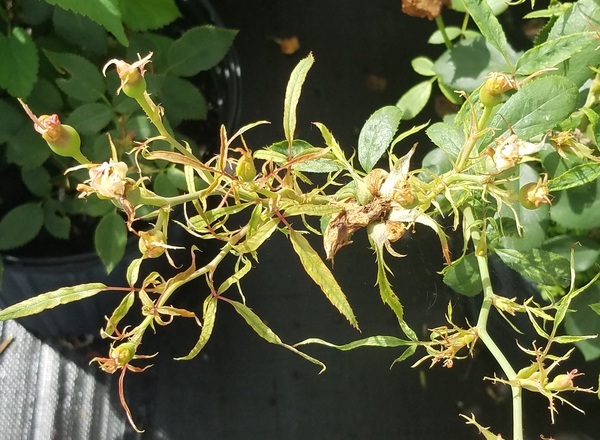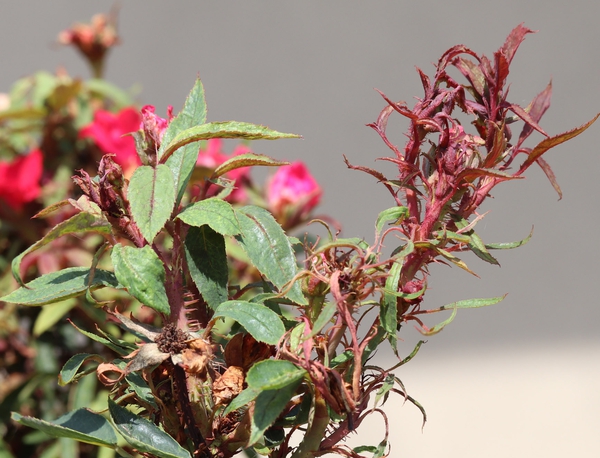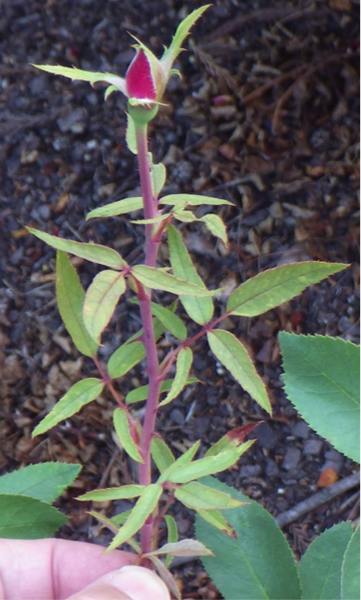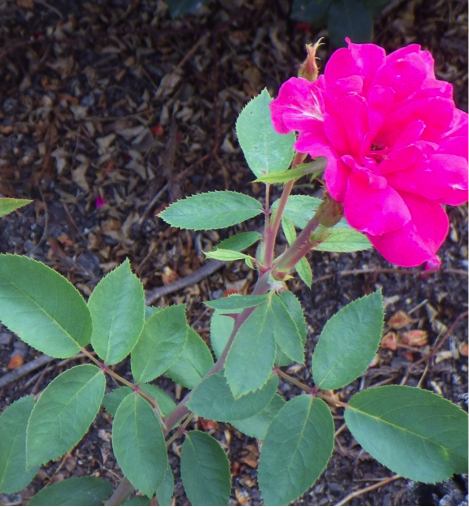Problem
Herbicide injury from glyphosate: a non-selective, systemic herbicide.
Symptoms
- Initially, new tissue chlorosis on most grasses and broadleaves.
- Chlorosis progresses to tip necrosis in 5 to 10 days.
- Necrosis of entire plant within 3 weeks.
- Woody plants or glyphosate resistant weeds may re-sprout.
- Re-sprouting tissue may be chlorotic, malformed, strap-shaped, witches broomed.
- In woody perennial weeds, symptoms may re-occur up to 3 years after exposure.
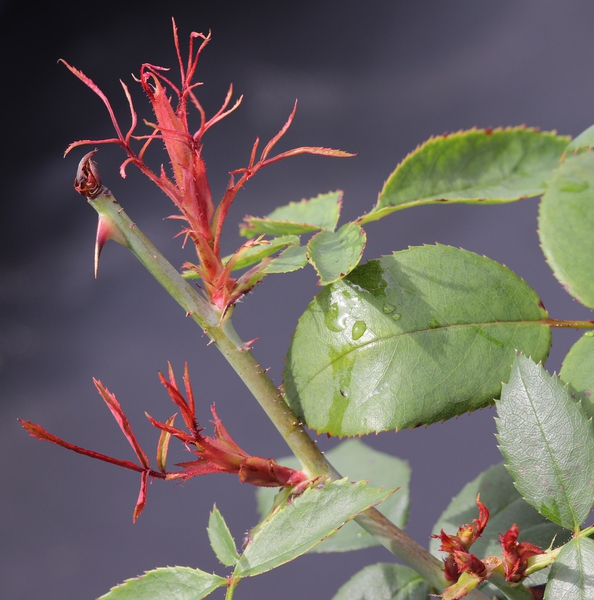
glyphosate root uptake on rose 2 with red pigmentation. Note lack of thorn proliferation common to rose rosette.
J. Neal CC BY-NC 4.0
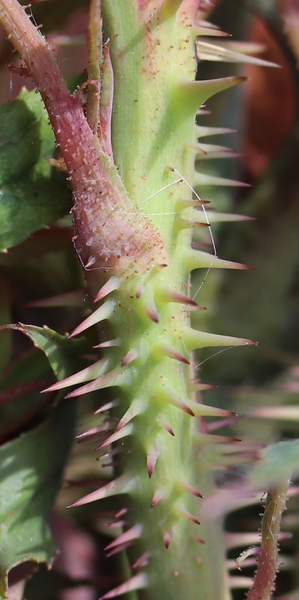
Look-alike -- rose rosette disease can look similar to glyphosate injury. Rose rosette often causes a proliferation of thorns; Glyphosate does not.
J. Neal CC BY-NC 4.0
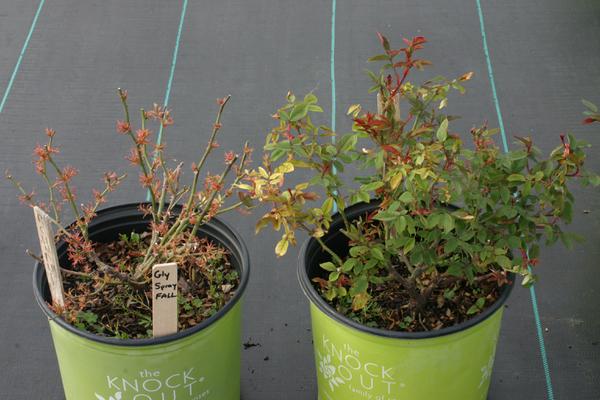
Fall applied glyphosate on knockout rose causes variable symptoms the following spring.
J. Neal CC BY-NC-SA 4.0
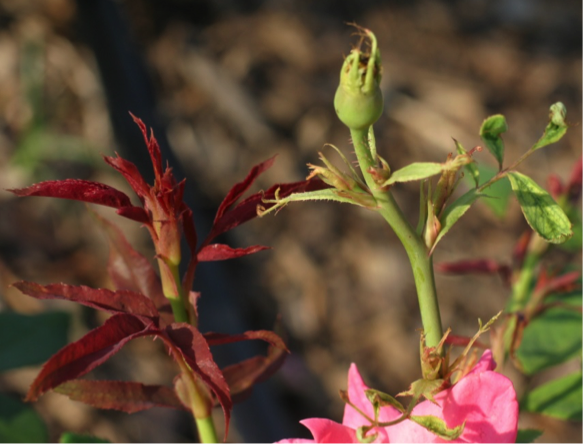
Knockout rose, non-treated new growth on the left; treated on the right. Two weeks after treatment.
J. Neal CC BY-NC-SA 4.0
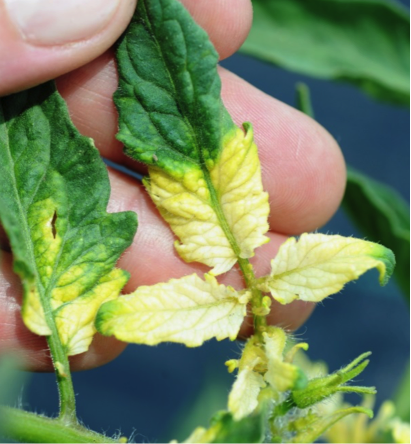
Glyphosate spray drift, systemic injury to tomato, 5 days after treatment.
B. Lassiter CC BY-NC-SA 4.0
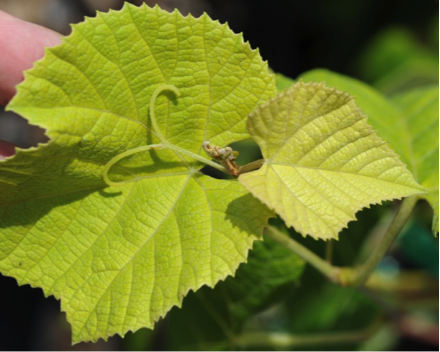
General chlorosis on new growth of grape, 5 days after glyphosate spray drift.
B. Lassiter CC BY-NC-SA 4.0
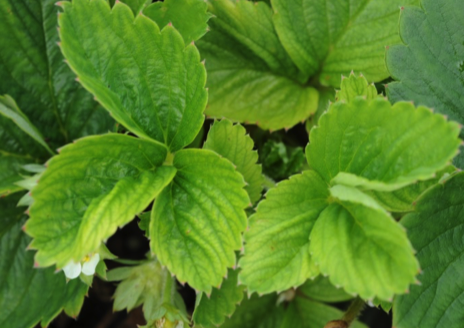
Strawberry new growth is yellowed from glyphosate spray drift, 21 days after treatment.
B. Lassiter CC BY-NC-SA 4.0
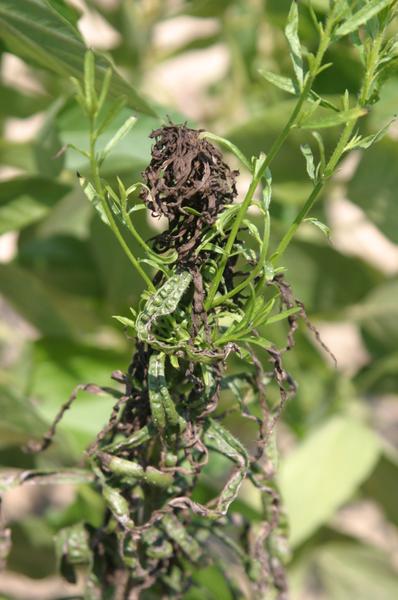
Glyphosate resistant horseweed resprouts after glyphosate treatment damages the growing point.
J. Neal CC BY-NC-SA 4.0
Plant Entry and Symptom Expression
Foliar applied and symplastically translocated throughout the plant. Root absorption is rarely possible, only in sand or other soilless substrates. Not volatile. Crop injury is most likely as a result of misapplication or spray drift.
Similar Problems
Glyphosate injury may be confused with symptoms from:
- Desiccation – loss of cell turgor pressure; salt accumulation.
- Frost damage – non-selective injury to plant tops.
- Paraquat (gramoxone) – rapid burn-down of all above ground tissue; regrowth possible.
- ALS inhibitor herbicides may produce nearly identical chlorosis and tip die-back.
- In woody plants, strap-shaped distorted foliage may resemble auxin herbicide damage, ALS inhibitor herbicides, or plant virus (such as rose rosette virus).
Herbicide Mode of Action Category
WSSA / HRAC – 9
Useful Resources
North Carolina Agricultural Chemicals Manual
Southern Region Small Fruit Consortium
Southeastern US Vegetable Crop Handbook
Weed Management in Nurseries, Landscapes & Christmas Trees Information Portal
Herbicide Handbook, Weed Science Society of America
Applied Weed Science: Including the Ecology and Management of Invasive Plants (3rd Edition), Merrill Ross & Carol Lembi, pages 165, 170-172.
Publication date: Sept. 10, 2015
Reviewed/Revised: Oct. 13, 2021
Recommendations for the use of agricultural chemicals are included in this publication as a convenience to the reader. The use of brand names and any mention or listing of commercial products or services in this publication does not imply endorsement by NC State University or N.C. A&T State University nor discrimination against similar products or services not mentioned. Individuals who use agricultural chemicals are responsible for ensuring that the intended use complies with current regulations and conforms to the product label. Be sure to obtain current information about usage regulations and examine a current product label before applying any chemical. For assistance, contact your local N.C. Cooperative Extension county center.
N.C. Cooperative Extension prohibits discrimination and harassment regardless of age, color, disability, family and marital status, gender identity, national origin, political beliefs, race, religion, sex (including pregnancy), sexual orientation and veteran status.

